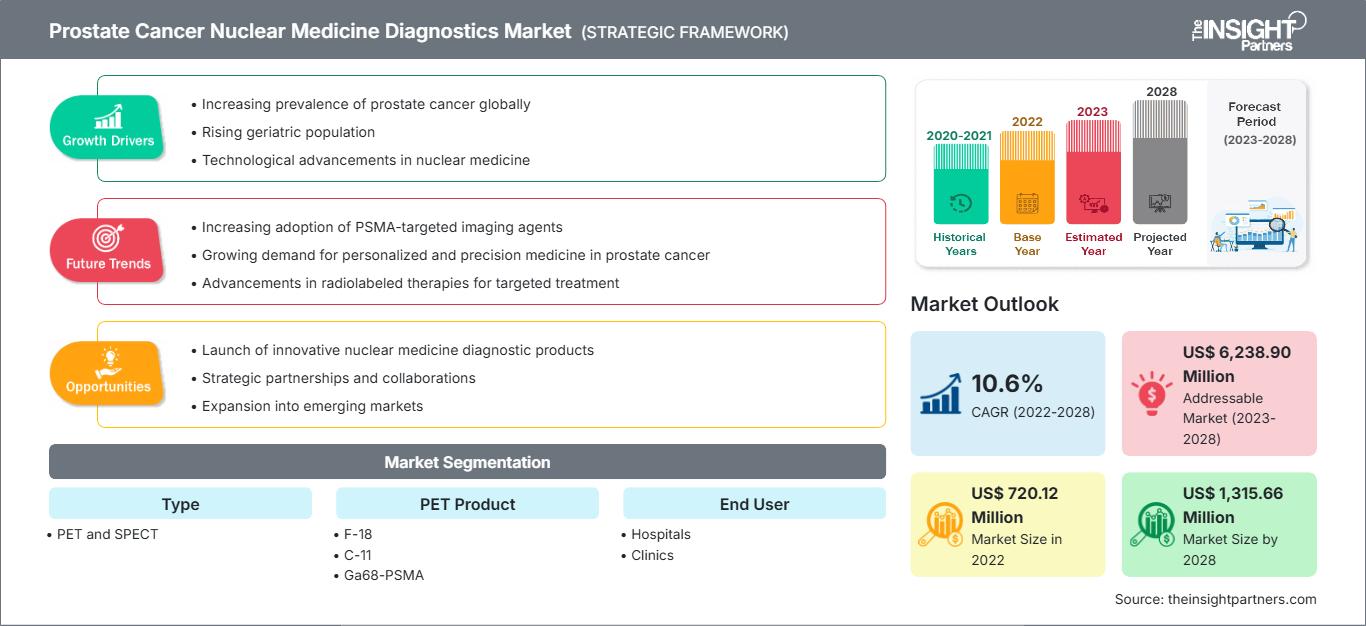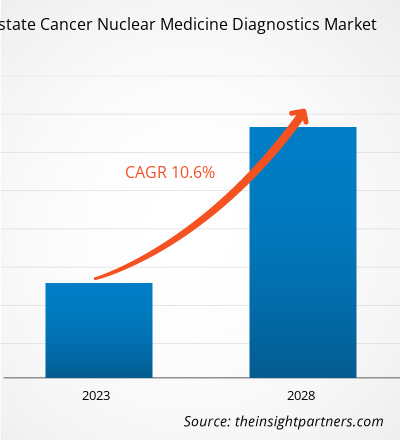Der Markt für nuklearmedizinische Diagnostik bei Prostatakrebs soll von 720,12 Millionen US-Dollar im Jahr 2022 auf 1.315,66 Millionen US-Dollar im Jahr 2028 wachsen. Von 2022 bis 2028 wird mit einer durchschnittlichen jährlichen Wachstumsrate (CAGR) von 10,6 % gerechnet.
Prostatakrebs betrifft die Vorsteherdrüse des Mannes. Nach Hautkrebs ist Prostatakrebs bei Männern eine häufige Krebsart. Zu den häufigsten Faktoren, die für die Entstehung von Prostatakrebs verantwortlich sind, gehören familiäre Belastung, hohes Alter und ethnische Zugehörigkeit. Nuklearmedizin ist eine bildgebende Methode, die radioaktive Materialien benötigt. Sie ist eine hilfreiche Methode zur Erkennung und Behandlung von Prostatakrebs und unterstützt Radiologen bei der Bestimmung des Krebsstadiums. Der Markt für nuklearmedizinische Diagnostik bei Prostatakrebs wird nach Typ, PET-Produkt, Endverbraucher und Geografie analysiert. Geografisch ist der Markt grob in Nordamerika, Europa, Asien-Pazifik, den Nahen Osten und Afrika sowie Süd- und Mittelamerika unterteilt. Der Marktbericht zur nuklearmedizinischen Diagnostik von Prostatakrebs bietet Einblicke und eine eingehende Analyse des Marktes und hebt Parameter wie Markttrends, Marktdynamik und die Wettbewerbsanalyse der weltweit führenden Marktteilnehmer hervor.
Passen Sie diesen Bericht Ihren Anforderungen an
Sie erhalten kostenlos Anpassungen an jedem Bericht, einschließlich Teilen dieses Berichts oder einer Analyse auf Länderebene, eines Excel-Datenpakets sowie tolle Angebote und Rabatte für Start-ups und Universitäten.
Markt für nuklearmedizinische Diagnostik bei Prostatakrebs: Strategische Einblicke

-
Holen Sie sich die wichtigsten Markttrends aus diesem Bericht.Dieses KOSTENLOSE Beispiel umfasst Datenanalysen, die von Markttrends bis hin zu Schätzungen und Prognosen reichen.
Markteinblicke
Steigende Nachfrage nach früher und präziser Diagnose von Prostatakrebs treibt den Markt für nuklearmedizinische Diagnostik bei Prostatakrebs an
Der Anstieg des PSA-Werts erhöht das Prostatakrebsrisiko. Der PSA-Wert im Blut wird in Nanogramm pro Milliliter (ng/ml) gemessen. Es gibt keinen definitiven Grenzwert, der bestimmen kann, ob ein Mann Prostatakrebs hat oder nicht. Um zu beurteilen, ob ein Mann weitere Tests benötigt, wählen viele Ärzte einen PSA-Grenzwert von 4 ng/ml oder höher, während andere empfehlen, bei einem niedrigeren Wert wie 2,5 oder 3 zu beginnen. Daher kann durch die Bestimmung des PSA-Werts im Blut eines Mannes Prostatakrebs frühzeitig erkannt werden.
Eine digitale rektale Untersuchung (DRE) ist eine weitere Methode zur Erkennung von Prostatakrebs. Der Arzt tastet während der Untersuchung die Prostatadrüse mit einem behandschuhten, eingeschmierten Finger ab. Regelmäßiges Screening mit einem gut validierten Biomarker könnte zu einer schnelleren Erkennung lokaler Erkrankungen führen. Darüber hinaus ist die Unterscheidung zwischen niedrig- und hochgradigen Erkrankungen entscheidend, um unnötige Biopsien, eine Unterbehandlung schwerer Erkrankungen und eine Überbehandlung indolenter Erkrankungen zu vermeiden.
Im Folgenden sind einige Beispiele von Unternehmen aufgeführt, die neue Produktentwicklungen und Produktzulassungen auf den Markt gebracht haben:
- Im April 2022 gab Telix bekannt, dass sein Prostatakrebs-Bildgebungsmittel Illuccix (Kit zur Herstellung von Gallium Ga 68 Gozetotid), auch bekannt als 68Ga-PSMA-11-Injektion, in den USA kommerziell erhältlich sein wird.
- Im März 2022 gab Novartis bekannt, dass die FDA Pluvicto (Lutetium Lu 177 Vipivotid-Tetraxetan) (früher bekannt als 177Lu-PSMA-617) zur Behandlung erwachsener Patienten mit prostataspezifischem Membranantigen-positivem metastasiertem kastrationsresistentem Prostatakrebs (PSMA-positives mCRPC) zugelassen hat, der sich auf andere Körperteile ausgebreitet hat. (metastasierend).
- Im März 2022 genehmigte die FDA ein ergänzendes diagnostisches Bildgebungsmittel, Locametz, nach Radiomarkierung mit Gallium-68 zur Identifizierung PSMA-positiver Läsionen. Nach der Radiomarkierung kann dieses Bildgebungsmittel verwendet werden, um PSMA-positive Läsionen bei erwachsenen Patienten mit mCRPC durch eine Positronen-Emissions-Tomographie zu identifizieren.
Solche Produktentwicklungen von Marktakteuren treiben den Markt für nuklearmedizinische Diagnostik von Prostatakrebs voran.
Typ-Einblicke
Basierend auf dem Typ ist der globale Markt für nuklearmedizinische Diagnostik von Prostatakrebs in SPECT und PET segmentiert. Das PET-Segment hatte 2021 den größten Marktanteil. Darüber hinaus wird für dasselbe Segment im Prognosezeitraum die höchste durchschnittliche jährliche Wachstumsrate (CAGR) auf dem Markt erwartet. Die Akzeptanz von PET als Diagnoseinstrument nimmt deutlich zu, da es eine höhere Genauigkeit als andere Diagnosetechniken bietet. Die Genauigkeit der Diagnose hat einen direkten Einfluss auf Entscheidungsprozesse und Behandlungsüberwachungsprozesse. Die steigende Nachfrage nach diesen Diagnoseverfahren dürfte das Wachstum des Marktes für nuklearmedizinische Diagnostik von Prostatakrebs im Prognosezeitraum ankurbeln.
Service-Einblicke
Basierend auf PET-Produkten ist der globale Markt für nuklearmedizinische Diagnostik von Prostatakrebs in F-18, C-11 und Ga68-PSMA segmentiert. Das F-18-Segment wird voraussichtlich im Jahr 2022 den größten Marktanteil halten. Allerdings wird erwartet, dass das Ga68-PSMA-Segment im Prognosezeitraum die höchste durchschnittliche jährliche Wachstumsrate (CAGR) auf dem Markt verzeichnet. Ga68-PSMA ist ein nicht-invasiver Diagnoseansatz, der eine verstärkte Expression des prostataspezifischen Membranantigens (PSMA) zur Bildgebung von Prostatakrebs nutzt. PSMA ist ein Transmembranprotein, das in der gesamten Prostata vorkommt. Die PSMA-Expression ist bei verschiedenen Krebsarten hochreguliert, Prostatakrebs weist jedoch die höchsten Werte auf. Darüber hinaus hat die PSMA-Expression einen prädiktiven Wert für den Krankheitsverlauf. PET erzeugt semiquantitative Bilder, die eine nicht-invasive Messung der PSMA-Expression durch Messung der dreidimensionalen Verteilung von Ga68-PSMA ermöglichen.
Partnerschaften und Kooperationen sind bei den Akteuren auf dem globalen Markt für nuklearmedizinische Diagnostik von Prostatakrebs weit verbreitete Strategien. Einige der wichtigsten Marktentwicklungen der letzten Zeit sind nachfolgend aufgeführt:
- Im April 2022 gab Telix eine Partnerschaft mit Avanço und THP bekannt, um das Prüfprodukt von Telix zur Bildgebung bei Prostatakrebs auf dem portugiesischen und österreichischen, tschechischen und slowakischen Markt zu vertreiben.
- Im August 2022 veröffentlichte Telix Einzelheiten zu zwei Zusatzstudien im Rahmen des ProstACT-Programms, darunter eine Phase-II-Studie in Zusammenarbeit mit GenesisCare.
- Im Februar 2021 gab Theragnostics eine Forschungsvereinbarung mit dem Universitätsklinikum Essen bekannt, um THG-008 für die PET-Bildgebung bei verschiedenen Krebsarten zu untersuchen, da radioaktiv markierte PARP-Inhibitoren das Potenzial haben, das Überleben von Krebspatienten zu verbessern.
Der Ausbruch der COVID-19-Pandemie hat einige günstige Szenarien für Akteure auf dem Markt für nuklearmedizinische Diagnostik bei Prostatakrebs aufgezeigt. In ganz Nordamerika sind zahlreiche Menschen von COVID 19 betroffen. Die USA sind ein stark betroffenes Land in Nordamerika. Die Infektion hat die geriatrische Bevölkerung des Landes schwer getroffen, verschiedene Komplikationen verursacht und zum Tod eines großen Teils der Bevölkerung geführt. So meldeten die USA bis zum 16. Mai 2022 84.230.829 COVID-Fälle mit 1.026.670 Todesfällen. Außerdem treten chronische oder nicht heilende Wunden meist bei älteren Menschen auf und brauchen länger, um zu heilen. Daher sind nuklearmedizinische Diagnostik und angemessene Pflege bei Prostatakrebs erforderlich, um chronischen Infektionsfällen und Gesundheitszuständen vorzubeugen.
Darüber hinaus waren aufgrund des Ausbruchs von COVID-19 verschiedene Krankenhäuser mit der Behandlung der betroffenen Menschen beschäftigt. Die COVID-19-Epidemie führte zu einem deutlichen Rückgang der Krebsvorsorgeuntersuchungen. Die Epidemie hat jedoch in den Vereinigten Staaten zu einem allgemeinen Mangel an Vorsorgeuntersuchungen geführt. COVID-19-bedingte Verzögerungen bei Krebsvorsorgeuntersuchungen werden als Ursache für zusätzliche überzählige Todesfälle angesehen, die in direktem Zusammenhang mit der Epidemie stehen. Die Diagnoseraten von Prostatabiopsien und Prostatakrebs sanken während der COVID-19-Pandemie, insbesondere während des Höhepunkts der Pandemie.
Zudem litten bildgebende Dienste in Europa, vor allem in Großbritannien, vor der Pandemie unter chronischen Unterinvestitionen und mangelnden Kapazitäten für Bildgebung und Befundung. Dies war beispielsweise auf einen erheblichen Mangel an Personal und Ausrüstung zurückzuführen. Mit den neuen IPC-Maßnahmen, insbesondere dem Social Distancing von 2 Metern in allen Gesundheitseinrichtungen, deckten diese Engpässe die CT-Kapazität zum Zeitpunkt der Erstellung dieses Artikels auf etwa 40–70 % des Niveaus vor COVID. Die MRT ist mit 80 % etwas besser. Darüber hinaus arbeiten die bildgebenden Dienste hart daran, durch den Wiederaufbau ihrer Kapazitäten und die Wiederherstellung des Patientenvertrauens wieder in Schwung zu kommen. Es ist klar, dass grundlegende Veränderungen nur mit erheblichen Investitionen zur Behebung der chronischen Unterfinanzierung von Radiologen, Röntgenassistenten und bildgebenden Geräten möglich sind.
Markt für nuklearmedizinische Diagnostik bei Prostatakrebs
Die Analysten von The Insight Partners haben die regionalen Trends und Faktoren, die den Markt für nuklearmedizinische Diagnostik bei Prostatakrebs im Prognosezeitraum beeinflussen, ausführlich erläutert. In diesem Abschnitt werden auch die Marktsegmente und die geografische Lage der nuklearmedizinischen Diagnostik bei Prostatakrebs in Nordamerika, Europa, im asiatisch-pazifischen Raum, im Nahen Osten und Afrika sowie in Süd- und Mittelamerika erörtert.Umfang des Marktberichts zur nuklearmedizinischen Diagnostik bei Prostatakrebs
| Berichtsattribut | Einzelheiten |
|---|---|
| Marktgröße in 2022 | US$ 720.12 Million |
| Marktgröße nach 2028 | US$ 1,315.66 Million |
| Globale CAGR (2022 - 2028) | 10.6% |
| Historische Daten | 2020-2021 |
| Prognosezeitraum | 2023-2028 |
| Abgedeckte Segmente |
By Typ
|
| Abgedeckte Regionen und Länder |
Nordamerika
|
| Marktführer und wichtige Unternehmensprofile |
|
Dichte der Marktteilnehmer im Bereich der nuklearmedizinischen Diagnostik bei Prostatakrebs: Verständnis ihrer Auswirkungen auf die Geschäftsdynamik
Der Markt für nuklearmedizinische Diagnostik bei Prostatakrebs wächst rasant. Dies ist auf die steigende Nachfrage der Endverbraucher zurückzuführen, die auf Faktoren wie veränderte Verbraucherpräferenzen, technologische Fortschritte und ein stärkeres Bewusstsein für die Produktvorteile zurückzuführen ist. Mit der steigenden Nachfrage erweitern Unternehmen ihr Angebot, entwickeln Innovationen, um den Bedürfnissen der Verbraucher gerecht zu werden, und nutzen neue Trends, was das Marktwachstum weiter ankurbelt.
- Holen Sie sich die Markt für nuklearmedizinische Diagnostik bei Prostatakrebs Übersicht der wichtigsten Akteure
Nuklearmedizinische Diagnostik bei Prostatakrebs – Marktsegmentierung
Der globale Markt für nuklearmedizinische Diagnostik bei Prostatakrebs wird nach Typ, PET-Produkt, Endverbraucher und Geografie analysiert. Nach Typ ist der Markt in PET und SPECT unterteilt. Nach PET-Produkt ist der Markt in F-18, C-11 und Ga68-PSMA segmentiert. Nach Endverbraucher ist der Markt in Krankenhäuser, Kliniken und Sonstiges segmentiert. Geografisch ist der Markt für nuklearmedizinische Diagnostik bei Prostatakrebs in Nordamerika, Europa, Asien-Pazifik, Naher Osten und Afrika sowie Süd- und Mittelamerika unterteilt.
Unternehmensprofile
- Blue Earth Diagnostics Limited
- ImaginAb
- Curium
- Jubilant Radiopharma
- NCM-USA LLC
- ABX advanced biochemical Compounds GmbH
- Telix Pharmaceuticals Ltd.
- Novartis AG
- Theragnostics
- Lantheus Medical Imaging, Inc.
- Historische Analyse (2 Jahre), Basisjahr, Prognose (7 Jahre) mit CAGR
- PEST- und SWOT-Analyse
- Marktgröße Wert/Volumen – Global, Regional, Land
- Branchen- und Wettbewerbslandschaft
- Excel-Datensatz
Aktuelle Berichte
Verwandte Berichte
Erfahrungsberichte
Grund zum Kauf
- Fundierte Entscheidungsfindung
- Marktdynamik verstehen
- Wettbewerbsanalyse
- Kundeneinblicke
- Marktprognosen
- Risikominimierung
- Strategische Planung
- Investitionsbegründung
- Identifizierung neuer Märkte
- Verbesserung von Marketingstrategien
- Steigerung der Betriebseffizienz
- Anpassung an regulatorische Trends






















 Kostenlose Probe anfordern für - Markt für nuklearmedizinische Diagnostik bei Prostatakrebs
Kostenlose Probe anfordern für - Markt für nuklearmedizinische Diagnostik bei Prostatakrebs